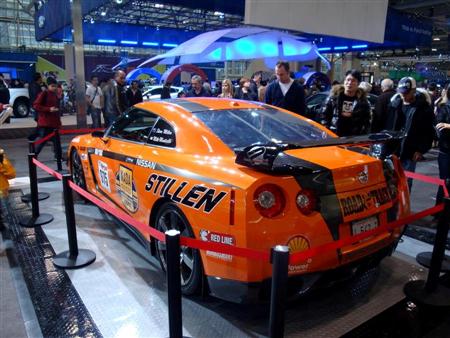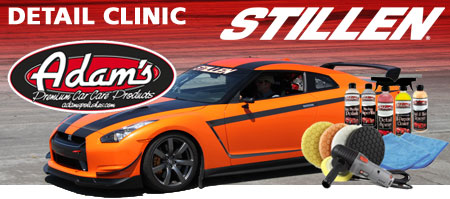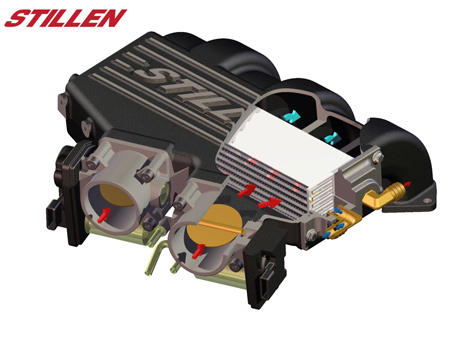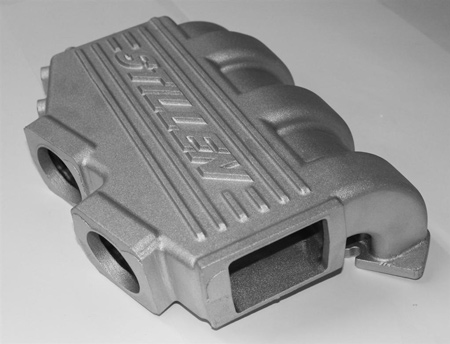- STILLEN GT-R Video with glowing AP Racing Carbon Ceramic Rotors featured on @Jalopnik.. Thanks Matt! http://bit.ly/a22OoT #
- Random blowout: We’ve had an OEM Nissan 350Z Auto Trans sitting here – Dumping it under cost if anyone needs one – http://bit.ly/bLIZp4 #
Kyle@STILLEN
STILLEN GT-R in Nissan Booth at Canadian International Auto Show
Earlier this month we said goodbye again to the STILLEN R35 GT-R after getting the call from Nissan that they would like to bring the GT-R back into Canada for the 2010 Canadian International Auto Show in Toronto.
Nissan arranged for transport, and placed the Targa GT-R in the center of their booth, giving attendees a chance to get inches away from the Orange Godzilla and get a peek for themselves. The show runs through February 21, 2010. [Pictures & Video after the jump]
TBWA\Toronto, Nissan’s agency in Canada put together this video of the GT-R on location at the show:
OFFICIAL NISSAN PRESS RELEASE:
Mississauga, Ontario – The Stillen GT-R that competed at the 2009 Targa Newfoundland will be on display at Nissan’s booth at the Canadian International Auto Show in Toronto in February.
Race car driver Steve Millen and his Stillen crew completed a tear-down and build-up of the GT-R to compete in the Newfoundland tarmac rally race.
“Nissan is excited to provide GT-R fans with this special appearance,” said Jeff Parent, vice-president of sales and marketing at Nissan Canada. “The Stillen crew showed us all just how mean ‘Godzilla’ can be, so we wanted to give fans a chance to get up close and personal to this great machine.”
While many modifications were made, the major change was a weight reduction of 78 kilograms over the stock model, along with increased throttle response and appropriate suspension changes.
The Stillen GT-R reached 96 km/h in 2.9 seconds, compared to 3.5 seconds in the stock version.
Here’s some photos of the GT-R at the event, taken by Ryan Cash with rwdftw.com:
If you haven’t seen the STILLEN GT-R in action, here’s a couple of in-car footage of stages during the 2009 Targa Newfoundland Rally:
STILLEN R35 GT-R – Brigus Stage – Day 5
STILLEN R35 GT-R – Gander Stage – Day 2
Adam’s Polishes Detail Clinic at STILLEN Recap & Future Clinic in March
STILLEN had a Detail Clinic with Adam’s Polish and it was a beautiful sunny day, perfect for a good car detail. People where out in full force to see Dylan and Ashley from Adam’s demo the full product line they have to offer. The coffee was flowing and donuts being consumed as Dylan was explaining the importance of proper detailing techniques.
Everything you ever needed to know about detailing was explained, waxing to even the correct towels to use. Participants were even given the opportunity to roll up their sleeves and get down and dirty with the clay bar to help get their rides the ultimate mirror smooth finish. The day concluded with a Q&A session where customer could ask specific car detailing question and even had Dylan work on there own personal cars!
Thanks to everyone who came out that morning it was a huge success and we at STILLEN plan to have events like this In March!
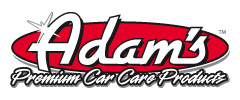
Twitter Weekly Updates for 2010-01-29
- That’s the plan, but no news yet, 370Z / G37 first.. RT @tsui_san: Burning question for VQ35HR owners – will the G37 supercharger fit?? #
- I’ll have to check.. what does the butt dyno tell you? RT @kaipodiesel: @STILLEN how much horsepower does the intake make? #
- Nice! Doing the install yourself? Should be no big deal if you have basic tools.. RT @kaipodiesel: My @STILLEN intake comes in on Monday!! #
- And the reason the STILLEN supercharged G37 isn’t on the dyno.. hail in Southern California.. (video) http://bit.ly/8cr9VP #
- First video teaser of STILLEN VQ37 Supercharger System.. as installed on a G37 – http://bit.ly/8g5Iax #
- First teaser pic of the STILLEN 370Z / G37 Supercharger.. as installed on a G37 – http://bit.ly/5c1JXf #
- Will start the trek to Canada soon! RT @autoshowcanada: The Nissan Stillen GTR will be at the Toronto #Autoshow #
Twitter Weekly Updates for 2010-01-22
- Looks clean to me.. Love that color.. 🙂 RT @CexiDeja: Diamond Girl…… NOT at her best http://twitpic.com/ydjun @STILLEN #
- STILLEN Supercharged G37 being driven today! If it stops raining we’ll finish the tuning and wrap up the 370Z as well! Videos/pics soon! #
- Awesome! Let me know what you think.. RT @kaipodiesel: @STILLEN Thank you!! I put in my order for my intake for my truck #
- 370Z / G37 VQ37 Supercharger Progress: STILLEN Intake Manifold and Intercooler technical details.. http://bit.ly/76tkUp #
370Z / G37 Supercharger System Progress: Intake Manifold Detailed
In the last update post we showed the new Intake Manifold and discussed the function of the Air-to-Water Intercooler System. Heres some more details on the design of the Intake Manifold and the engineering behind the STILLEN VQ37 Supercharger System.
As you can see we have relocated the throttle bodies to one side of the intake manifold. There are several reasons for this:
Intercooler Installation – Our intercooler is actually incorporated into the intake manifold. This dramatically decreases the intake air temperatures right before the engine receives the air. On the 350Z we found that the intercooler removed over 100 degrees immediately before the air entered the engine. There are other intercooler styles available, such as the water boxes that Vortech offers that are before the throttle body. Unfortunately on the VQ37 this would have significantly increased the cost, having two intercoolers and all of the associated plumbing, as well as space required in the engine bay would have been a major issue. Additionally, there is a lot of residual heat inside of an engine bay. Heat coming off of exhaust manifolds, the engine block, valve covers and more. Running two pipes across the top of all of this heat would only cause the air to re-heat inside the pipe prior to going into the engine. By cooling the air in the manifold immediately prior to its introduction into the engine we are getting the air as cool as possible.
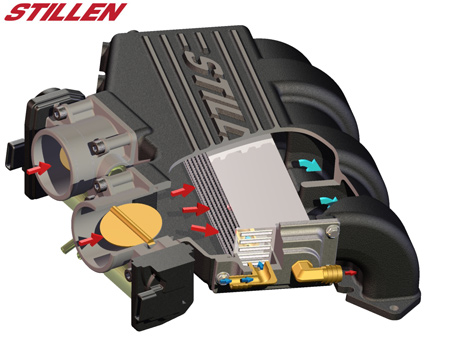
Equal Pressurization – Yes, it would have been possible to simply use a Y-pipe design coming off the supercharger that went into the throttle body. The problem with this design is the different length tubes would cause an unequal amount of air entering the intake manifold on each side. Imagine a centrifugal supercharger mounted behind the headlight on either side of the vehicle. On the supercharger side, the air would only have to travel a foot or two to one throttle body, but on the opposite side the air would have to travel three feet across the front of the core support then another two feet back to the throttle body. This differential in distance means that one side of the plenum is seeing boost well before the other side, causing uneven air flow and pressure. This potentially could cause issues with tuning, power delivery, and could even cause additional turbulence inside the intake pipes. If both throttle bodies are open and one is receiving forced air but the other is still requiring the engine to be sucking air this will cause a large amount of turbulence inside the intake manifold. By equalizing the length of pipe that the air has to travel through, the engine will receive forced air in the intake manifold equally through both throttle bodies, thus reducing any turbulence.
Equal Air Distribution – It is very important to ensure that the air pressure is equal prior to going into the manifold, but it is even more important that the air is distributed evenly to each cylinder. The factory intake manifold has a very aggressive slope towards the front of the manifold. Combine that with the fact that the throttle bodies are aimed rearward, this could cause the front two cylinders to not get enough air thus causing the two front cylinders to run rich. By running rich and having more fuel than necessary in those cylinders it is actually hurting power and performance. By redesigning the intake manifold we are able to supply each cylinder with an equal volume of air which allows each cylinder to produce the most power possible and to work at its maximum level of efficiency.
Longer Runners – Another design that was incorporated into the intake manifold was a larger intake runner. By lengthening the intake runners we are able to increase torque which will help greatly with acceleration.
Here’s some higher resolution images of the 3D CAD renderings:
STILLEN Supercharger Development Posts
- 370Z / G37 Supercharger System Progress: R&D
- 370Z / G37 Supercharger System Progress: Intake Manifold & Intercooler
- 370Z / G37 Supercharger System Progress: Intake Manifold Design & Detail [Current]
- 370Z / G37 Supercharger System: Official Press Release
- 370Z / G37 Supercharger System: Endurance Testing Continues
370Z / G37 Supercharger System Progress: Intake Manifold & Intercooler
After the decision was made to go with the Vortech Centrifugal Supercharger, work began on developing the kit. The engineers spent hours under the hood of our project G37 Coupe taking measurements, test fitting parts, and checking the tight clearances to see where they could put all of the necessary components. The new VQ37 has a very unique and challenging dual throttle body intake design. The STILLEN engineers have had great success with making big power off this design and a perfect example of that are the Generation 3 Intakes which offer up to 18 horsepower! However, the supercharger was going to require some creative thinking and once again, the engineers have pulled it off!
Here are some pictures of the STILLEN-designed intake manifold done with our 3D CAD software, and some of the new aluminum castings just received before final machining:
All of the engineering for this intake manifold has been done in-house. We began by developing several designs in our 3-Dimensional CAD programs which allow us to test virtual airflow and simulate installation and function on a “virtual engine.” Once the CAD drawings are completed the engineers “print” out a plastic part on our rapid prototype machine. This prototype is constructed out of a durable PVC plastic material and allows us to take our virtual work to the real world. With this prototype we can install the part on the engine to check our fit and finish, we can also use it for mock-up to run the intake piping, bolt up throttle bodies and route serpentine belts and more. We actually ran the car with this rapid prototype plastic manifold on the car which allowed us to check belt alignment and clearances while the engine was running.
Due to the overwhelming cost, we do not have an aluminum foundry in the back of our shop, so in certain instances like this some of our products have to be outsourced to specialists. These aluminum castings come back to our shop for final machining and finishing before being assembled with the intercoolers and the rest of the kit.
The company who does all of our castings also manufactures parts for some of the largest manufacturers in the industry including:
- TRD
- Roush Racing
- DART heads
- Chrysler
- Cosworth
- Bombardier
- Edelbrock
- and many, many more.
We are also very proud to say that they are based in the U.S.A. This is very important to STILLEN, as we feel too many companies these days outsource to other countries and we try our best to keep all of our manufacturing in-house or at least in the U.S.A.
The primary reason for engineering the new intake manifold is the inclusion of the intercooler in our Air-to-Water Intercooler System. Because of all of the heat built up during the compression of the supercharging process it is best to run some sort of intercooler system. There are two different types of intercooler systems, Air-to-Air and Air-to-Water. We chose to run an Air-to-Water system for many different reasons.
First question that usually comes up is: What is an intercooler, and what does it do?
An intercooler is essentially a radiator that cools the air compressed by a turbo or supercharger. Air-to-Water and Air-to-Air intercoolers essentially do the same job but go about it in two different ways, each having their pros and cons. The compression of the air by the supercharger or turbocharger causes the air charge to become superheated. When the air is heated it loses its density and also becomes less oxygen rich. An intercoolers function is to lower the intake air temperatures, thus regaining the density of the air and increasing the levels of oxygen in the air charge. Another benefit to the cooler air charge is the ability to run higher levels of boost, and more aggressive tuning without the concern of combustion anomalies.
Air-to-Water Intercoolers
Air-to-Water intercoolers are very similar to your cars cooling system. A water and coolant blend is cooled through a radiator/heat exchanger and is plumbed to the intercooler which is mounted inside the intake manifold. The compressed and superheated air coming out of the supercharger is blown across an intercooler which is being cooled by the water/coolant blend. This is where the heat is transferred from the charged air to the intercooler and removed back out to the heat exchanger. This thermal transfer cools the air at the last possible second before entering the engine thus guaranteeing the coolest air charge possible.
Air-to-Air Intercoolers
In an Air-to-Air system the superheated compressed air is cooled through the intercooler which is usually mounted up by the front bumper. The air then has to travel back to the intake manifold through metal tubing. This tubing is sitting inside the hot engine bay which is being heated by the air coming through various coolers such as, radiator, oil coolers, and also the heat coming off the exhaust manifolds, the engine block and the valve covers. The intercooler does remove a significant amount of heat but because the air has to travel back through the hot engine bay it is then being reheated before going into the engine.
Advantages / Disadvantages
A distinct advantage to an Air-to-Water intercooler is the condensed packaging. Air-to-Water intercoolers only require a relatively small heat exchanger in order to work efficiently. Think about how much outside air is coming through the front of your car. Now stick a heat exchanger or Air-to-Air intercooler in front of your radiator, oil cooler, transmission cooler, power steering cooler, and intakes. It quickly becomes clear that a large Air-to-Air intercooler is going to consume a large majority of the cool, fresh air coming in from the outside which also needs to be used to cool other vital components of your vehicle. Because an Air-to-Water heat exchanger is substantially smaller it does not need to consume as much cool air that can be used by other coolers for the car.
Air-to-Water intercoolers are actively cooling the water inside the cooling system by continually pumping the coolant utilizing an electric water pump. This means that it is effective and efficient at any speed. An Air-to-Air intercooler system greatly relies on the vehicle’s speed to generate sufficient airflow around the intercooler. This means that in real world conditions the Air-to-Air intercooler is not getting any air flowing through it while it pulls heat off of surrounding vehicles and off the road surface itself. At the same low speed or stop light situation the Air-to-Water system is actively circulating the coolant.
The only downside to an Air-to-Water intercooler system is the cost. Because there are two coolers, water pump and additional hoses and fittings for the plumbing the cost is a bit higher than just one large air to air intercooler. However, the performance benefits far outweigh the cost differences in our opinion for this application.
Look for additional updates soon!
STILLEN Supercharger Development Posts
- 370Z / G37 Supercharger System Progress: R&D
- 370Z / G37 Supercharger System Progress: Intake Manifold & Intercooler [Current]
- 370Z / G37 Supercharger System Progress: Intake Manifold Design & Detail
- 370Z / G37 Supercharger System: Official Press Release
- 370Z / G37 Supercharger System: Endurance Testing Continues
Twitter Weekly Updates for 2010-01-15
- RT @albertroxas: @Stillen Targa Race GTR @ C&C last sat http://www.albertroxas.com/wordpress/wp-content/uploads/2010/01/gtr_stillen.jpg #
- Video tour of STILLEN and GT-R test drive thanks to @TheSmokingTire and crew coming down.. Great HD video Matt! http://bit.ly/7tMNY0 #
- Hmm.. Don’t know how I missed this. Nice blog post on our last GT-R meet, with great photos of the IMSA 300ZX – http://bit.ly/61kBAz #
- Love the sound of the 5.6L with that combo.. RT @Infiniti_Dealer: here is a nice Stillen QX56… Listen to it Roar! http://bit.ly/6WEqbQ
TheSmokingTire.com Video Tour Behind The Scenes At STILLEN
A little while back we had a chance to meet up with Matt Farah and his awesome crew from TheSmokingTire.com and show them around the buildings here at STILLEN.
Matt and Steve then jumped in the bright orange STILLEN GT-R and took a run through some of the local canyons. See below for the video!
Matt started The Smoking Tire video series last year, and previous to that was the driving force behind Garage419. Two minutes with him is all it takes to recognize that he’s a true car enthusiast, and he’s as genuine as he comes across in his videos. Be sure to check out and subscribe to his video series here.
Adam’s Polishes Detail Clinic at STILLEN – Jan 16th
Join us Saturday, January 16th at STILLEN as we host the first BIG Detail Clinic of 2010!
STILLEN relies on Adam’s Polishes to keep all of our show cars looking the way they were meant to be, and we’re opening up the shop to give our customers an up-close look at these detailing products in action.
Adam’s experts will be on hand, demoing Adam’s most popular products, new detailing tools and accessories, and giving you first hand advice for getting the absolute best shine possible. Plus, there will be one-day-only special savings and FREE Adams’s samples for all that attend.

The clinic runs from 9AM until whenever, with the official Adam’s Polishes demos from 9AM-10AM.
Have a particular detailing question or challenge you’d like us to address? Just let us know and we’ll be ready with answers. And if possible, bring the car in question – we’ll work on it on the spot!
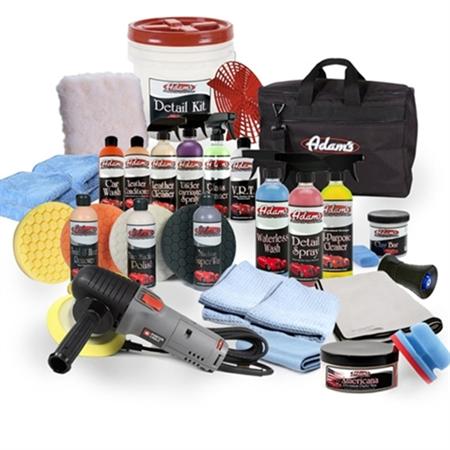
Adam’s Polishes are also available for sale and shipping from the STILLEN website: Adam’s Polishes
Click here for a map to STILLEN: Google Map

